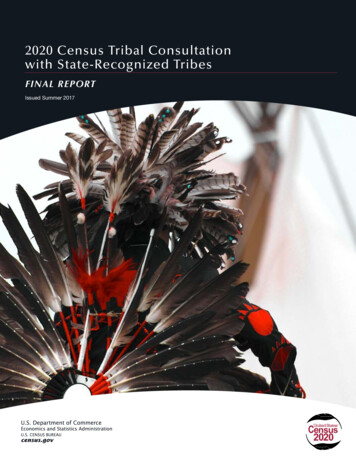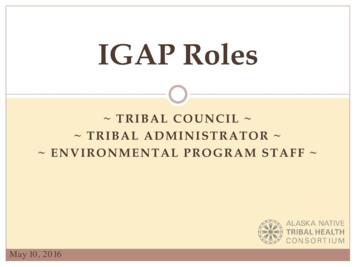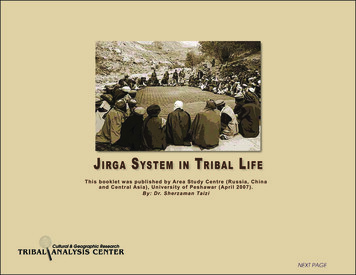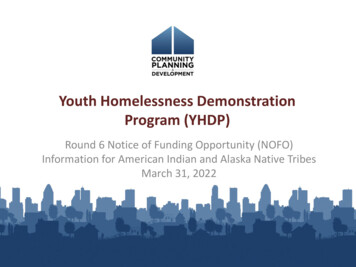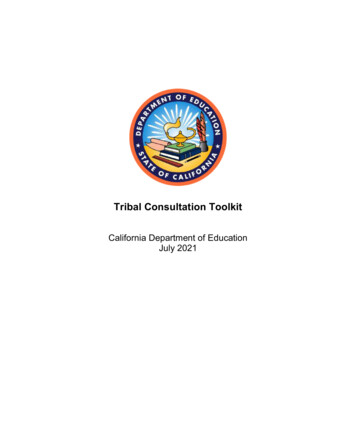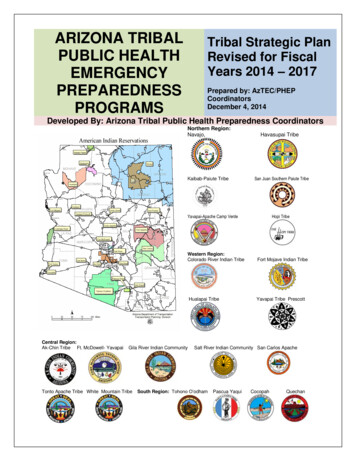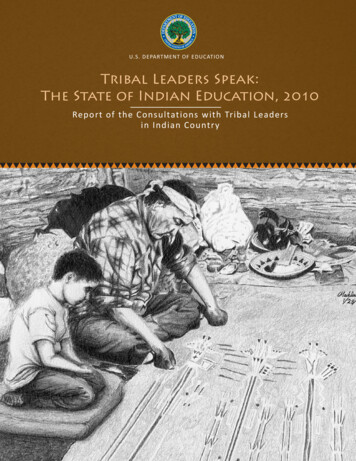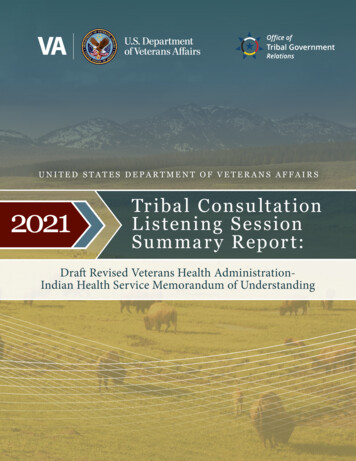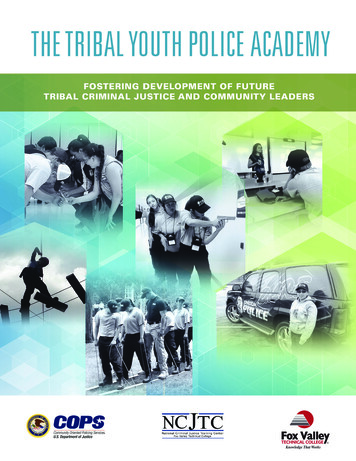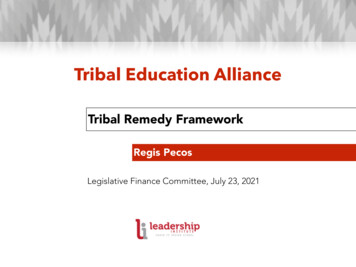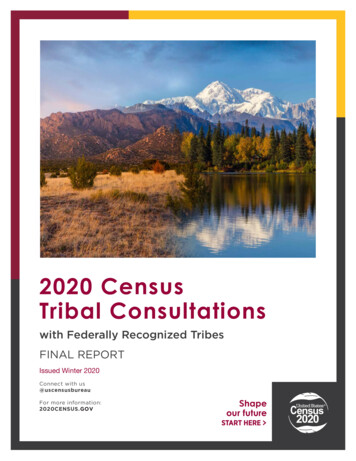
Transcription
2020 CensusTribal Consultationswith Federally Recognized TribesFINAL REPORTIssued Winter 2020Connect with us@uscensusbureauFor more information:2020CENSUS.GOV
AcknowledgementsWe extend our gratitude to the tribal delegates and other tribal participants whoattended the tribal consultations with the Census Bureau and whose input is containedin this report.Census Bureau and Department of Commerce executive leadership who participatedin the consultations included Dr. Steven Dillingham, U.S. Census Bureau Director,and Anthony Foti, Director of Intergovernmental Affairs for the U.S. Department ofCommerce.The following Census Bureau staff delivered short presentations at the meetings:Michael Hawes, Nicholas Jones, Rachel Marks, and Roberto Ramirez.Regional office directors who participated in the consultations includedJulie Lam, Los Angeles Regional Director and Cathy Lacy, Denver Regional Director.Dee Alexander (Cheyenne and Arapaho Tribes of Oklahoma), Tribal Affairs Coordinator,had primary responsibility for the tribal consultation meetings and the final report.Kauffman & Associates, Inc., an American Indian-owned firm, was contracted to providelogistical support for the 2020 Census tribal consultations and develop the final reports.2020 Tribal Consultations with Federally Recognized Tribes Final Reporti
Table of ContentsAcknowledgements. . . . . . . . . . . . . . . . . . . . . . . . . . . . . . . . . . . . . . . . . . . . . . . . . iExecutive Summary. . . . . . . . . . . . . . . . . . . . . . . . . . . . . . . . . . . . . . . . . . . . . . . . . 1The 2020 Census Tribal Consultation Process. . . . . . . . . . . . . . . . . . . . . . . . . . . 2Consultation Logistics and Preparation. . . . . . . . . . . . . . . . . . . . . . . . . . . . . . . . 2Dates and Locations. . . . . . . . . . . . . . . . . . . . . . . . . . . . . . . . . . . . . . . . . . . . . . . . . . . .Census Bureau Support. . . . . . . . . . . . . . . . . . . . . . . . . . . . . . . . . . . . . . . . . . . . . . . . .Contractor Support . . . . . . . . . . . . . . . . . . . . . . . . . . . . . . . . . . . . . . . . . . . . . . . . . . . .Meeting Agenda and Structure. . . . . . . . . . . . . . . . . . . . . . . . . . . . . . . . . . . . . . . . . . .Tribal Consultation Participants. . . . . . . . . . . . . . . . . . . . . . . . . . . . . . . . . . . . . . . . . .23333Tribal Consultation Themes . . . . . . . . . . . . . . . . . . . . . . . . . . . . . . . . . . . . . . . . . . 42020 AIAN Race Question . . . . . . . . . . . . . . . . . . . . . . . . . . . . . . . . . . . . . . . . . . . . . . 4Data Privacy . . . . . . . . . . . . . . . . . . . . . . . . . . . . . . . . . . . . . . . . . . . . . . . . . . . . . . . . . . 5Overarching Theme: Enumeration. . . . . . . . . . . . . . . . . . . . . . . . . . . . . . . . . . . . . . . . 6iiUnited States Census Bureau
Summary of Recommendations. . . . . . . . . . . . . . . . . . . . . . . . . . . . . . . . . . . . . . . 7Conclusion. . . . . . . . . . . . . . . . . . . . . . . . . . . . . . . . . . . . . . . . . . . . . . . . . . . . . . . . . 7Follow-Up Items. . . . . . . . . . . . . . . . . . . . . . . . . . . . . . . . . . . . . . . . . . . . . . . . . . . . 8Completed Action Items. . . . . . . . . . . . . . . . . . . . . . . . . . . . . . . . . . . . . . . . . . . . . . . . 8Appendix A. Meeting Notes: AFN Tribal Consultation. . . . . . . . . . . . . . . . . . . . 92020 Census Bureau Tribal Consultation in Fairbanks, AK . . . . . . . . . . . . . . . . . . . 9Appendix B. Meeting Notes: NCAI Tribal Consultation . . . . . . . . . . . . . . . . . . 222020 Census Bureau Tribal Consultation in Albuquerque, NM. . . . . . . . . . . . . . . 222020 Tribal Consultations with Federally Recognized Tribes Final Reportiii
Executive SummaryThe Census Bureau strives to build partnerships with tribal nations and engage with tribesindividually to ensure accurate counts of tribal citizens. In October 2019, the Census Bureauconducted tribal consultations with member tribes of the Alaska Federation of Natives(AFN) and the National Congress of American Indians (NCAI) in conjunction with eachorganization’s annual conference. The Census Bureau held these consultations to provideupdates on the race question and inform tribes about its new data disclosure avoidancemethodology. This report summarizes, by topic, the input tribal leaders provided on thesetopics, as well as other topics that emerged during the dialogue. Major discussion pointsincluded: Capturing accurate, detailed race data for tribal citizens, especially for large, multifamily households; Tribal and federal uses of census data about AIAN people, including specific dataproduct requests from some tribes; and Enumeration approaches for tribal communities.This report summarizes the dialogue between tribal delegates and the Census Bureau oneach topic and identifies tribal recommendations. These recommendations include: Allow for the identification of multiple heads of household within one household; Consider approaches for ensuring detailed race data are captured for largehouseholds; Provide data products to tribes that include the greatest level of detail possiblegiven the limitations of differential privacy; Provide the following data products to meet the specific tribal data requests— fCitizen Potawatomi Nation—The number of AIAN people living in Oklahomaand the overall AIAN population in southern Texas;fSalt River Pima-Maricopa Indian Community—All tabulations it has receivedfrom past censuses;fInter Tribal Council of Arizona —The number of tribal communities that havea population under 2,500 people, median household income, and averagehousehold size; andfNavajo Nation—Chapter-level tabulations; andHire local, bilingual enumerators.The report concludes by outlining action items identified during the meeting. Detailed notesfrom the tribal consultations are attached as appendices.2020 Tribal Consultations with Federally Recognized Tribes Final Report1
The 2020 Census Tribal Consultation ProcessThe Census Bureau prioritizes engaging with tribal nations and building partnerships withtribes to promote an accurate count of tribal citizens in the decennial census. The correctcharacterization of tribal populations helps tribes justify adequate funding, ensure fairrepresentation, and conduct effective planning.Led by the Census Bureau’s Office of Congressional and Intergovernmental Affairs, theagency began holding tribal consultations 5 years in advance of the 2020 Census toincorporate tribal input into its design. In 2015 and 2016, the Census Bureau held 16 tribalconsultations and a national webinar with federally recognized tribes. This series of tribalconsultations helped the Census Bureau tailor the design of the census to tribal needs,respond to tribal questions and concerns, and strengthen partnerships with tribal nations.In 2019, the Census Bureau conducted two additional tribal consultations to provideupdates on the census race question, inform tribes about its new data disclosure avoidancemethodology, and gather feedback about tribal data needs. This report summarizes, bytopic, the input tribal leaders provided on data products and disclosure avoidance, as well asother topics that emerged during the dialogue.Consultation Logistics and PreparationThe Census Bureau coordinated with the Alaska Federation of Natives (AFN) and theNational Congress of American Indians (NCAI) to host tribal consultations in conjunctionwith each organization’s annual conference.Dates and LocationsTable 1 lists the tribal consultation locations, dates, and the overarching event.LocationDateEventFairbanks, AKOctober 16, 2019AFN Tribal LeadersConferenceAlbuquerque, NMOctober 21, 2019NCAI Annual MeetingTable 1. Tribal consultation locations and dates2United States Census Bureau
Census Bureau SupportStaff from the Census Bureau’s 2020 American Indian and Alaska Native (AIAN) Programcoordinated the tribal consultations and oversaw the development of the final report.Census Bureau Director, Dr. Steven Dillingham, participated in both tribal consultations,along with Census Bureau headquarters staff and leadership and staff from the Los Angelesand Denver Regions.Contractor SupportThe Census Bureau contracted with Kauffman & Associates, Inc., (KAI) an American Indianowned professional services firm, to support meeting planning and logistics and developthe final report. KAI provided logistic, registration, and note-taking services. Following eachtribal consultation, KAI developed summary notes for each meeting and created this finalreport.Meeting Agenda and StructureThe meeting agenda was designed with a flexible structure to stimulate discussion andgather tribal input. The tribal consultations opened with introductions, followed by openingremarks from Director Dillingham. Next, the Census Bureau delivered brief presentationsto provide updates on the census question on race and the proposed new approach todisclosure avoidance. Open discussions followed the presentations.Tribal Consultation ParticipantsParticipants at the consultations included tribal leaders and official tribal delegates;representatives of tribes, intertribal groups, and AIAN organizations; and Census Bureauexecutive leadership, regional leadership, and headquarters and regional staff.In total, 218 tribal participants attended the two tribal consultations, representing 91tribes and 16 tribal or intertribal organizations. At the AFN tribal consultation, 138 tribalparticipants attended, representing 58 tribes, villages, and Alaska Native corporations,as well as 12 tribal organizations. At the NCAI tribal consultation, 70 tribal attendeesparticipated, representing 35 tribes and 4 tribal or intertribal organizations. Additionally, twotribes attended both consultations.Dr. Steven Dillingham, U.S. Census Bureau Director and Anthony Foti, Director ofIntergovernmental Affairs for the U.S. Department of Commerce, attended both tribalconsultations. Julie Lam, Los Angeles Regional Director, participated in the AFN tribalconsultation, and Cathy Lacy, Denver Regional Director, participated in the NCAI tribalconsultation.2020 Tribal Consultations with Federally Recognized Tribes Final Report3
Tribal Consultation ThemesThis portion of the report summarizes, by topic, the guidance, suggestions, questions, andcomments from tribal delegates.2020 AIAN Race QuestionThe Census Bureau has worked to update the census question on race. Per U.S. Office ofManagement and Budget (OMB) guidance, the Census Bureau defines AIAN people as “aperson having origins in any of the original peoples of North and South America (includingCentral America), and who maintains tribal affiliation or community attachment.” 1Based on insights gathered through research, tribal consultation, and focus groups, theCensus Bureau has updated the question on race to better capture details of AIAN identity.Updates include having: Added a set of detailed examples for the AIAN option, Expanded the number of characters the write-in space can capture from 30 to 200, and Expanded the number of detailed responses a respondent can write in from two to six.The AIAN code list is the Census Bureau’s guide for tabulating responses to the racequestion and turning them into data. Currently, the Census Bureau is updating the listaccording to feedback. The Census Bureau welcomes additional edits and will workto incorporate all updates prior to the 2020 Census. However, with the 2020 Censusapproaching soon, some edits may not take effect until after the census. The CensusBureau will follow up with the tribal leaders who requested code list updates at the tribalconsultations.Tribal InputSeveral tribal delegates at the NCAI tribal consultation indicated they had edits to the codelist that they would share with the Census Bureau.Ensuring that tribal citizens respond to the race question in such a way that the CensusBureau will code the response toward the appropriate tribe is a challenge that several tribaldelegates discussed. This challenge is especially difficult when a citizen of one tribe is livingon another tribe’s lands or in an urban area where they may feel somewhat disconnectedfrom their enrolled tribe. Additionally, citizens of Alaska Native Villages may write in theirregional corporation, rather than the name of their village. To promote self-identificationby tribal citizens in a way that will count toward federally recognized tribes, tribes mustconduct outreach to their constituents about how to appropriately respond to the racequestion.1462 FR 58782, OMB Standards for Maintaining, Collecting and Presenting Federal Data on Race and Ethnicity, 1997United States Census Bureau
Capturing accurate, detailed race information for members of large households is anotherchallenge that emerged at both tribal consultations. In tribal communities, multiple familiesoften reside in the same household. The census only permits one person per household toself-identify as the head of household, despite the multiple heads of household who maybe present in a multi-family home. Accurate representation of the number of families ineach home through the option to identify multiple heads of household would be beneficialinformation for tribes.An additional concern for large households is the limitations of the printed census form. Theprinted census form asks for detailed information on the head of household and offers ninesubsequent spaces for the head of household to list additional household members. Afterthe sixth space, the question no longer asks for detailed race information. In cases where ahousehold contains family members or boarders of different races, capturing racial data forthe entire household is challenging.Data PrivacyAs technology evolves, the Census Bureau needs to modernize the way it protects theprivacy of individual responses to the Census Bureau. The Census Bureau plans to transitionto differential privacy, which helps avoid revealing the identities of individuals or individualhouseholds by adding a predetermined amount of uncertainty to the data. Differentialprivacy protects the privacy of individual responses while still producing accurate data.This new approach will reshape the data products, to some extent, and some detailed dataproducts from past censuses may not be feasible for the 2020 Census data.The Census Bureau would like to know which data products tribes use and how they usethe data to determine how to implement differential privacy while still meeting tribal dataneeds. More specifically, the Census Bureau needs to know how tribes use data on peoplewho are AIAN alone, data on people who are AIAN alone and in combination with otherraces, demographic and housing characteristic data, and data tabulated for different levelsof geography. The Census Bureau posed the following questions to tribal consultationparticipants: Do you use both data on AIAN alone and data on AIAN alone or in combination fordetailed data for tribes and villages? What levels of geography do you need for these detailed data (e.g., tribal tract,place)? What programmatic, statutory, or legal uses are there for these detailed data? How much funding is distributed based on these detailed data? Why are decennial census statistics used for this purpose?The Census Bureau will conduct more tribal consultations in 2020 to notify tribes of whichdata products it will provide.2020 Tribal Consultations with Federally Recognized Tribes Final Report5
Tribal InputTribal delegates requested that the Census Bureau provide the greatest level of detailpossible in its 2020 Census data products. Several tribes requested specific data productsduring the tribal consultations, as shown in Table 2.Tribe or OrganizationCitizen Potawatomi NationData Needs The number of AIAN people living inOklahoma The overall AIAN population in southernTexasSalt River Pima-Maricopa IndianCommunity All tabulations it has received from pastcensusesInter Tribal Council of Arizona The number of tribal communities thathave a population under 2,500 people,median household income, and averagehousehold sizeNavajo Nation Chapter-level tabulationsTable 2. Specific data products requestedSeveral tribal delegates described concerns about possible improper federal uses of censusdata products. One such concern is that that federal agencies who use census data todevelop funding formulas would base their funding allocations on the smaller dataset forpeople who are AIAN alone, even though tribes provide services to populations who areAIAN alone and in combination and often to non-tribal members. The Census Bureau isa data collection agency, not a policy agency, and thus cannot dictate how other federalagencies use the data it produces. The Census Bureau recommended that tribes raise thisissue in tribal consultation with other agencies to encourage them to use census data in away that is most fair to tribes.The participants discussed the importance of submitting updated tribal geographicboundaries to the Census Bureau through the Boundary and Annexation Survey (BAS) ifa tribe has purchased new property or changed their boundaries. These updated mapsare how the Census Bureau will tabulate 2020 data for each tribal geography. The CensusBureau will conduct one more BAS before the 2020 Census in January 2020.Overarching Theme: EnumerationEven though enumeration approaches were not an official agenda item, this topic arose atboth tribal consultations. Below is a summary of the dialogue around enumeration of AIANpeople and communities.6United States Census Bureau
Tribal delegates emphasized the importance of the Census Bureau hiring local enumeratorsto count tribal communities. Local knowledge will help locate residences who have noaddresses or are disconnected from road systems, ensure enumeration does not occurduring ceremonies or observances, and serve as trusted local voices to encourage tribalcitizens to respond. Bilingual enumerators who speak the tribal language will be a majorasset to a successful census in tribal communities.Several tribal delegates inquired about how the Census Bureau counts the homeless andthose who reside away from home temporarily, such as in college housing, medical carefacilities, and detention centers. The Census Bureau works with communities to identify areaswhere homeless people gather, including shelters, soup kitchens, and camps. Enumeratorsthen visit these locations during times when people are most likely to be present. The CensusBureau conducts a group quarters operation to count people who temporarily reside awayfrom their usual home, such as at a nursing home. Enumerators visit these locations and askresidents where their permanent home is or consult the facility’s administrative records ifthey cannot ask.Summary of RecommendationsThe following recommendations emerged from the 2019 tribal consultations: Allow for the identification of multiple heads of household within one household. Consider approaches for ensuring detailed race data are captured for largehouseholds. Provide data products to tribes that include the greatest level of detail possiblegiven the limitations of differential privacy. Provide data products to meet the specific tribal data requests identified in Table 2. Hire local, bilingual enumerators.ConclusionThe Census Bureau appreciates the robust participation in these meetings and the valuableinput tribal delegates provided in preparation for the 2020 Census and subsequent dataproducts. The dialogue helped to clarify the Census Bureau’s processes for enumeration anddata tabulation, gave tribes a forum to convey additional questions and concerns regardingthese processes, informed tribes about the proposed differential privacy approach, andprovided the Census Bureau with insights on what data products are most helpful for tribes.The tribal consultations strengthened partnerships between the Census Bureau and tribes,which will serve as a foundation to gather an accurate count of AIAN people in the 2020Census and provide beneficial data for tribal use.2020 Tribal Consultations with Federally Recognized Tribes Final Report7
Follow-Up ItemsThis section lists follow-up items or commitments made by the Census Bureau during thetribal consultations and indicates the actions the Census Bureau has taken and will take tofollow up with tribal questions, comments, and concerns.Completed Action ItemsMr. Ramirez met with several tribal delegates immediately after the tribal consultation toreceive updates and edits for the code list. The Census Bureau followed up with all triballeaders who requested edits to the code list.The Census Bureau provided the followingresponse to a tribal delegate’s question aboutwhat the envelope containing the censusquestionnaire will look like: The envelope isapproximately 10 inches by 6 inches, with awindow near the bottom right corner thatshows a barcode, an alphanumeric responseID, and a hand-written address of the placewhere the questionnaire was sent or left.The left side of the envelope will include theDepartment of Commerce emblem and U.S.Census 2020 logo, the U.S. Census BureauAn example of the official census questionnaire envelopeaddress (Jeffersonville, IN), an official businessnotice that states “penalty for private use 300,” and a message within a text box in Englishand Spanish that reads “Your response is required by law. We have not yet received yourresponse.”The Census Bureau provided the following response regarding whether large householdscan complete more than one census questionnaire to ensure all household members andheads of household are accurately recorded: The questionnaire collects information on up to10 household members. The form includes all census questions, including race, for the firstsix of these 10. The best way to ensure all characteristics of a large household are collectedis for the household to self-respond online or call Census Questionnaire Assistance.8United States Census Bureau
Appendix A . Meeting Notes: AFN TribalConsultation2020 Census Bureau Tribal Consultation in Fairbanks, AKWednesday, October 16, 20192019 Alaska Federation of Natives Tribal Leaders ConferenceFairbanks Pipeline Training Center, Fairbanks, AKParticipantsAlaska Federation of Natives (AFN) AttendeesAt the AFN tribal consultation, 138 tribal participants attended, representing 58 tribes,villages, and Alaska Native corporations, as well as 12 tribal organizations. Nathan Bergerbest Jill Boskofsky, Board Member,Kodiak Area Native Association Tara Bourdukofsky, Director,Aleutian Pribilof Island Association Richard Bouse, Sr., Retired Greg Bringhurst, FairbanksRegional Director and Rural Advisor,U.S. Senate Joanne Bryant, TribalCommunication & OutreachSpecialist, U.S. Fish and WildlifeServiceHarvey Anelon, Vice President,Iliamna Natives Limited Gloria Burns, Tribal Council,Ketchikan Indian Community Isadore Anthony, Tribal President,Native Village of Nightmute Romy Cadiente, Tribal RelocationCoordinator, Newtok Village Council Tammy Ashley, Director, AlaskaNative Justice Center Matt Carle, Director of CommunityOutreach, Sealaska Corporation Marty Awalin, President/CEO, CullyCorporation Nikoosh Carlo, Founder, CNC NorthConsulting Peggy Azuyak, Board Member,Kodiak Area Native Association Wally Carlo, Director, Doyon,Limited George Beans, Council President,Yupiit of Andreafski Linda Belton, Senior Policy Advisorfor Intergovernmental Affairs andTribal Liaison, U.S. National Oceanicand Atmospheric AdministrationTanna Carter, ExecutiveCoordinator, Tanana ChiefsConference Pearl Chanar, Vice President, SethDe-Ya-Ah Village Corporation Tom Andersen, Tribal Council ViceChairman, Native Village of Eyak Michelle Anderson, President,Ahtna, Inc. Loren Anderson, Council Member,Native Village of Afognak Desiree Andon, PreventionCoordinator, Tanana ChiefsConference Amanda Andraschko, Native AffairsLiaison, Alaskan Command Nancy Andrew, CEO, St. Mary’sNative Corporation 2020 Tribal Consultations with Federally Recognized Tribes Final Report9
David Charles, Tribal CourtAdministrator, Akiachak Tribal Court Billy Charles, Chairman, EmmonakCorporationJudith Eaton, Executive TribalSecretary, Metlakatla IndianCommunity Renee Charlie, Shareholder, Doyon,LimitedAmber Ebarb, Legislative Assistantfor U.S. Senator Lisa Murkowski George Edwardson, President,Inupiat Community of the ArcticSlope Joaqlin Estus, Reporter, IndianCountry Today Eileen Ewan, President, GulkanaVillage Council Felicia Ewan, Village CouncilMember, Gulkana Village Council Maia Fabrizio, Kickapoo Tribe ofOklahoma Adrienne Fleek, Alaska NativeAffairs Liaison, U.S. National ParkService Crystal Frank, Graduate Studentand Administrative Coordinator ofCross-Cultural Studies, University ofAlaska Fairbanks Larry Chichenoff, Board Member,Kodiak Area Native Association Jaclyn Christensen, Full Board,Bristol Bay Native Association Meagan Christiansen, Chairman,Native Village of Afognak Alex Cleghorn, Legal and PolicyDirector, Alaska Native JusticeCenter 10 Maria Coleman, Tribal Council VicePresident, Native Village of Eklutna Elizabeth Cook, Native Liaison, U.S.Army Garrison Alaska Amber Cunningham, CouncilMember, Native Village ofUnalakleet Darian Danner, Government AffairsAssociate, Arctic Slope RegionalCorporation Margaret Galovin, Self-GovernanceCoordinator, Aleutian PribilofIslands Association Lorraine David, Project Director,Fairbanks Native AssociationIndigenous Language Project Rick Garcia, Director of TribalJustice Department, Association ofVillage Council Presidents Rita Dayton, Tribal Citizen, KoyukukTribe Audrey George, CEO, ANCAccounting Joyce DeCarufel, Doyon, Limited/Native Village of Tanacross Carol Gore, President/CEO, CookInlet Housing Authority Joe Demantle, Tribal Court Judge,Tulkisarmiut Sara Gray, Executive Assistant U.S.Attorney, U.S. Attorney’s Office Agnes Denny, Tribal Administrator,Cheesh’na Tribal Council Margaret Guidry, Council President,Pitka’s Point Traditional Council James P. Dunham, Tribal CouncilMember, Native Village of Afognak Will Hanbury, Jr., Tribal Council,Sitka Tribe of Alaska Colleen Dushkin, Administrator,Association of Alaska HousingAuthorities Kristi Harper, U.S. Fish and WildlifeServiceUnited States Census Bureau
Darlene Herbert, Member, NativeVillage of Fort Yukon Leila Kimbrell, State Director, U.S.Senator Lisa Murkowski Sharon Hildebrand, VillageOutreach Liaison, Doyon, Limited Raeanne Holmes, CommunicationsCoordinator, Central Council of theTlingit and Haida Indian Tribes ofAlaskaJaeleen Kookesh, Vice President,Policy & Legal Affairs, SealaskaCorporation Leonard Lampe, Executive BoardMember, Kuukpik Corporation Doreen Leavitt, Executive Director,Native Village of Barrow Aaron Leggett, President, NativeVillage of Eklutna Okalena Patricia Lekanoff Gregory,Board of Directors, OunalashkaCorporation Whitney Leonard, AssociateAttorney, Sonosky Chambers LawFirm MaryJane Litchard, Instructor,Kawerak, Inc. Jack Hopkins, Tribal CouncilMember, Native Village of Eyak Eloise Howard, Tribal Citizen, EagleVillage Jerry Isaac, Secretary/Treasurer,Tanana Chiefs Conference Doug Isaacson, CEO, MintoDevelopment Corporation Georgia Jackson, Council Member/AmeriCorps Resilient Alaskan YouthProgram Member, Native Village ofKluti-Kaah Theresa John, Associate Professor,Center for Cross Cultural Studies,University of Alaska FairbanksRaven Madison, Tribal CouncilMember, Native Village of Eyak Mary Ann Johnson, TribalAdministrator, Portage Creek VillageCouncilJordan Marshall, GovernmentAffairs/State Lobbyist, AlaskaRegional Coalition Fred Matsuon, Tribal CouncilTreasurer, Ugashik TraditionalVillage Kathy Mayo, Board Member,Northern Taiga Ventures, Inc.,Rampart Victor Joseph, Chief/Chairman,Tanana Chiefs Conference Leilani Kabbaz, Sugpiaq Emily Kameroff, Board Member,Emmonak Tribal Council Anna May Kasak, Tribal Citizen,Traditional Council of TogiakConnie Mayo, Tribal Citizen, TananaNative Council Chris McNeil Angela Michaud, Senior DirectorExecutive Tribal Services,Southcentral Foundation Ruth Miller Melanie Kasayulie Alexie, TribalCitizen, Akiachak Native Community Kailyn Kashevarof, AleutCorporation Sarah Katongan, Council Member,Native Village of Unalakleet Loretta Nelson, Vice Chairman,Native Village of Afognak Gayle Kildal, Transport Manager,Copper River Native Association Nancy Nelson, President, NativeVillage of Port Lions2020 Tribal Consultations with Federally Recognized Tribes Final Report11
Teri Nutter, President/CEO, CopperRiver Basin Regional HousingAuthority Emma Roach, Congressional andState Affairs Liaison, U.S. Fish andWildlife Service Sarah Obed, Senior Vice Presidentof External Affairs, Doyon, Limited Margaret Roberts, Vice-President,Tangirnaq Native Village Darrel Olsen, Tribal CouncilChairman, Native Village of Eyak Paul Rude, CEO, Copper RiverNative Association JJ Orloff, Tribal Administrator,Native Village of Afognak Robert Sam, Tribal Council, SitkaTribe of Alaska Alexander Ortiz, Deputy Chief ofStaff, U.S. Congressman Don Young Alex Panamar
executive leadership, regional leadership, and headquarters and regional staff. In total, 218 tribal participants attended the two tribal consultations, representing 91 tribes and 16 tribal or intertribal organizations. At the AFN tribal consultation, 138 tribal participants attended, representing 58 tribes, villages, and Alaska Native .
